⭐ BEST FERRY via CEBU & Countryside Tour: Our pick for Ferry Tickets and Countryside Tours.
- Bohol
- Bohol Travel
- Loboc
Discover the Tranquil Charm of Loboc - Your Ultimate Travel Guide
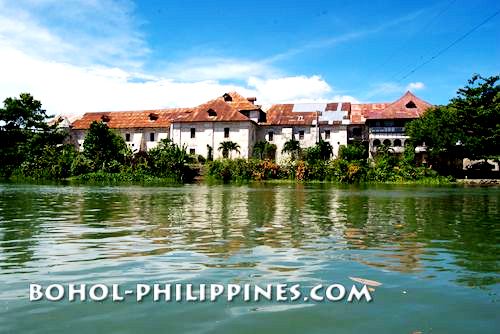
the enchanting town of Loboc Bohol, Philippines
Introduction: Welcome to Loboc, a hidden gem nestled in the heart of Bohol. With its tranquil ambiance and breathtaking natural beauty, Loboc offers an unforgettable travel experience. From riverside resorts offering stunning views of the meandering Loboc River, to cozy guesthouses providing an authentic local stay, and budget-friendly options for thrifty travelers, Loboc has it all. Explore the floating accommodations and wake up to the gentle sway of the river. Discover the rich culture, warm hospitality, and mesmerizing landscapes that Loboc has to offer. Get ready for an extraordinary journey through the peaceful charm of Loboc, Bohol.
what to Do and See in Loboc
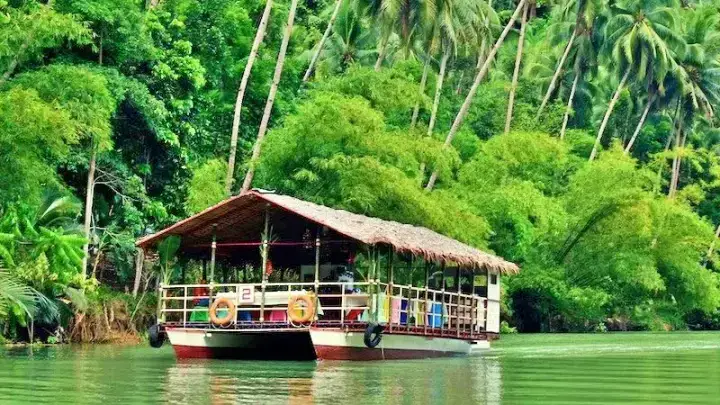
Loboc River Cruise
The Loboc River Cruise is a popular tourist activity in Bohol, Philippines. It involves a leisurely boat ride along the picturesque Loboc River, offering scenic views of the surrounding lush greenery and tranquil waters. The cruise typically includes onboard entertainment, cultural performances, and a buffet meal, allowing visitors to immerse themselves in the local culture while enjoying the beauty of nature.
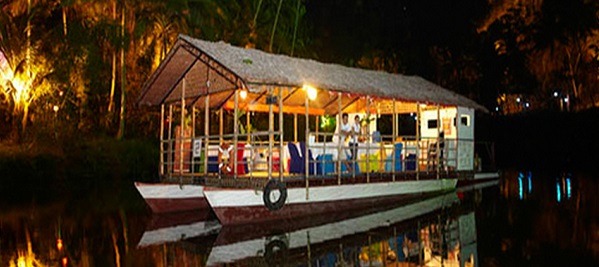
experience loboc River Dinner Cruise
The Loboc River Dinner Cruise provides a memorable dining experience aboard a floating restaurant while cruising along the Loboc River. Guests can indulge in a sumptuous buffet meal featuring local delicacies and international cuisine while enjoying the scenic views of the river and its surroundings. It is a perfect blend of delectable food, enchanting ambiance, and breathtaking natural beauty.
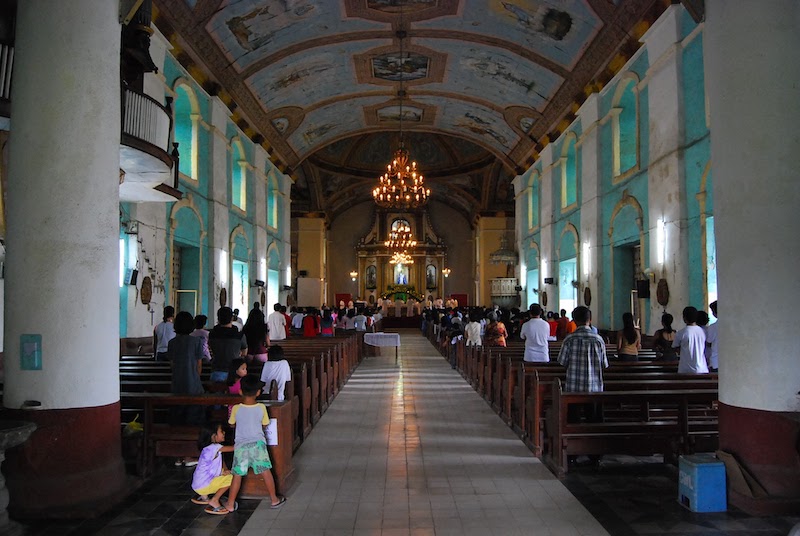
visit the church of St. Peter the Apostle
Visit the massive 300-year-old Loboc Church Of St. Peter The Apostle, which is a significant historical and architectural landmark in Loboc. Explore the church and its intricately designed interiors, and don't miss the three-storey convent that now houses a museum. The church celebrates its feast day on June 29th and another feast day on May 24th for its second patron, Nuestra Señora de Guadalupe.
Despite suffering damage from various earthquakes, the church remains an architectural marvel with its exquisite Spanish Baroque murals and carvings.
Ready to explore the beautiful islands of Cebu and Bohol? Secure your ferry tickets today through 12go and start your unforgettable journey!
what to do in loboc bohol
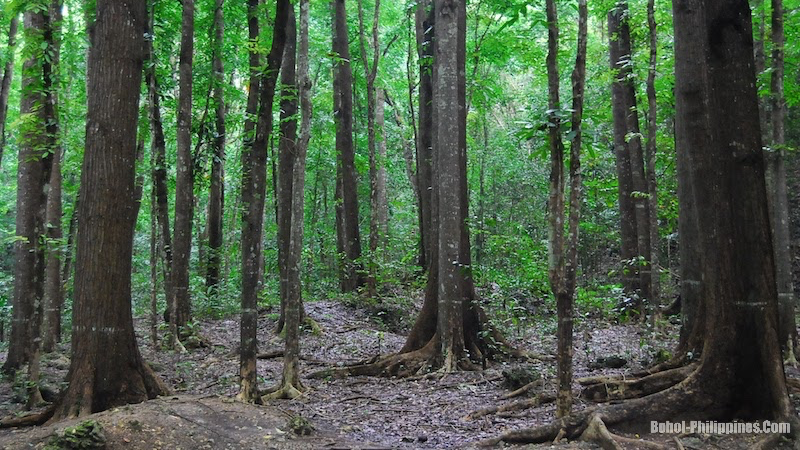
Immerse in the Enchanting Mahogany Man-Made Forest
Explore the enchanting Bilar Mahogany Man-Made Forest, a two-kilometer stretch of densely planted mahogany trees. This scenic forest, located at the outskirts of Loboc, offers a captivating drive along a winding road. Admire the uniformity and height of the majestic trees, providing a refreshing escape into nature.

Encounter the Fascinating Tarsiers
Get up close and personal with the adorable and fascinating tarsiers, considered the world's smallest primate. Tarsier Conservation Area is nestled in the picturesque barangay of Upper Bonbon, Loboc town. It is conveniently situated near the Loboc part of the man-made forest, making it easily accessible for visitors.
Enjoy the Melodies of Loboc Children's Choir
Don't miss the opportunity to listen to the renowned Loboc Children's Choir. This talented group has gained fame both locally and internationally, captivating audiences with their beautiful performances. Catch their concerts or purchase their CDs, which are available at the St. Peter the Apostle Church in Loboc.
Loboc is renowned as the music capital of the province due to its cultural and musical heritage. The Loboc Children's Choir, which gained international acclaim, put Loboc in the global spotlight. If you're lucky, you may have the chance to watch a performance by the choir or other musical groups in the town.
Experience Loboc's Rich Culture and Arts
Immerse yourself in Loboc's rich cultural heritage, particularly in the realm of music. Loboc has a long history of nurturing singers, composers, musicians, and music teachers. Witness the talent of local performers, including rondallas, music bands, adult choirs, and a brass symphonic ensemble.
loboc river adventures

Busay Falls: A Serene Oasis
Marvel at the picturesque Busay Falls, a serene spot along the river where the boats often stop. Take a moment to appreciate the green scenery or enjoy a refreshing dip near the falls. It's a favorite bathing place for locals and a great way to cool off during your visit.

Stand-up Paddleboarding
A fun way to explore the Loboc River is through stand-up paddleboarding. This activity gives you the chance to experience the river's calm water while surrounded by the verdant forest.
Get your adrenaline pumping with thrilling river adventures. Try kayaking, paddleboarding, or canoeing along the Loboc River, exploring its hidden corners and immersing yourself in its natural splendor. It's an exhilarating way to connect with nature while embracing the spirit of adventure.
Embark on an exciting journey in Loboc, a municipality in Bohol, Philippines, where adventure and natural beauty await. Get ready for action-packed activities and thrilling experiences that will leave you with unforgettable memories.
Take a river tour and immerse yourself in the breathtaking beauty of the Loboc River. Cruise along its tranquil waters, marvel at the scenic landscapes, and spot fascinating wildlife along the way. Let knowledgeable guides introduce you to the rich history and culture of the area as you explore key landmarks and attractions.
Witness the Magic of Firefly Watching
Experience the enchantment of firefly watching along the Loboc River. Hop on a boat and venture into the darkness of the night, where the riverbanks come alive with the mesmerizing glow of countless fireflies. It's a magical display of nature's wonders that will leave you in awe.
Soar Across the River with a Zip Line:
Feel the rush of adrenaline as you zip across the Loboc River on a thrilling zip line ride. Enjoy breathtaking aerial views of the lush landscapes below and let the wind whisk through your hair. It's an adventure that combines excitement with the beauty of nature.
Drift Peacefully on a Bamboo Raft:
Experience the serenity of the Loboc River on a traditional bamboo raft. Glide along the calm waters, guided by skilled boatmen, and immerse yourself in the tranquility of the surroundings. Listen to the gentle sounds of nature and take in the lush greenery as you peacefully drift along.
In Loboc, adventure and natural wonders blend harmoniously, offering a plethora of activities that cater to every thrill-seeker and nature enthusiast. Get ready to create lifelong memories as you embrace the excitement and beauty that await you in this captivating destination.
Loboc Eco-Tourism Adventure Park:
The Loboc Eco-Tourism Adventure Park is a nature park located in Loboc, Bohol. It offers a range of exciting outdoor activities, such as ziplining, rappelling, and trekking. Visitors can immerse themselves in the beauty of the park's lush greenery, encounter diverse flora and fauna, and experience thrilling adventures amidst the natural surroundings. The park is an ideal place to enjoy an adrenaline rush amidst stunning natural surroundings.
Krus Daku: Panoramic Views and Pilgrimage
Visit Krus Daku, a site featuring a towering white cross on top of the highest hill. Pilgrims come from far and wide, especially during Holy Week, to commemorate the Stations of the Cross. Enjoy panoramic views of neighboring towns, including Tagbilaran City, from this elevated vantage point.
Explore the Adventurous Guimba Cave
Embark on an adventurous exploration of Guimba Cave, a hideout during the Japanese invasion and now one of Loboc's attractions. Enter the cave through a tunnel-like structure and witness the breathtaking formations of stalactites and stalagmites that have been forming for centuries.
Thrilling Horseback Riding in Loboc
Experience the thrill of horseback riding through Loboc's verdant rolling terrain, steep slopes, and mango orchards. Explore the picturesque landscapes and enjoy the exhilaration of horseback riding, whether during the day or for a more thrilling experience at night.
Discover Loboc's Underground Wonders
Discover the fascinating underground world of Loboc through guided tours of several caves. Visit the famous Guimba cave and explore its tunnels and cave chambers adorned with mesmerizing stalactites and stalagmites. The caves provide an eerie and awe-inspiring experience.
Loboc offers a blend of natural wonders, cultural treasures, and thrilling adventures that will leave visitors with unforgettable memories of their time in this vibrant town in Bohol.
Bohol's Loboc Ancestral Houses
Explore the captivating Loboc ancestral houses that showcase the town's rich historical heritage. Discover unique architecture, intriguing stories, and cultural significance as you immerse yourself in the living history of Loboc. This travel guide invites you to experience the charm and allure of Bohol's Loboc Ancestral Houses. Start your adventure today!
Join loboc festivals
Loboc Festivals: The town of Loboc in Bohol is known for its vibrant festivals that celebrate Christian devotions and practices, with a strong emphasis on music and dance.
The church celebrates its feast day on June 29th and another feast day on May 24th for its second patron, Nuestra Señora de Guadalupe.
For the Lobocanons, these festivities are not only a form of celebration but also a way to express their religiosity and spirituality. Music and dance are seen as a means of prayer and offering, serving to glorify God and the saints.
Bolibom-Kingking Festival
If you have the opportunity to visit Loboc during the annual Bolibom-Kingking Festival, don't miss it.
This cultural community pageant showcases the different villages or barangays of Loboc competing in a dance drama rendition that portrays the town's rich cultural history.
It's a vibrant and much-attended event that offers a glimpse into Loboc's cultural heritage.
Loboc: Cuisine, Dining & shopping
What to Eat
Loboc offers a range of dining options where you can savor delicious Boholano cuisine. While enjoying the river cruise, indulge in a sumptuous buffet of local dishes, including fresh seafood, grilled meats, and tropical fruits. You can also explore the town and try local eateries that serve traditional Boholano delicacies like sikwate (hot chocolate) with puto (rice cake), binagol (sticky taro dessert), and calamay (sticky rice dessert).
Shopping and Souvenirs
Loboc is known for its native products and handicrafts. Take the opportunity to buy unique souvenirs such as wood and rattan chairs, baskets, and furniture made by skilled local craftsmen. You can also find locally made products like nipa shingles, ginger candy, squash toffee, and other sweet treats that make for great gifts or personal mementos.
Loboc: Geography & Climate
Enveloped by lush tropical forests, Loboc lies 24 kilometers away from Tagbilaran City, the capital of Bohol. The town sits along the Loboc River, a significant waterway that not only shapes the land but also the lives of the locals. Loboc enjoys a tropical climate with a year-round average temperature of 28 degrees Celsius. Rain is more frequent from June to November, with December to May offering the most comfortable weather for tourists.
Demographics & Culture
With a population of around 16,000 people, Loboc is a quaint town characterized by a laid-back rural lifestyle. The majority of Lobocanons are of Visayan ethnicity and speak Cebuano. English and Filipino are also commonly understood. The town is known for its vibrant culture, particularly music. The Loboc Children's Choir has won numerous international awards, showcasing the town's musical talent. Additionally, the yearly Sandugo Festival and the Loboc Youth Band Festival are cultural highlights that draw crowds from around the world.
A Captivating Blend of History and Present-day Charm in Loboc, Bohol
Nestled in the heart of Bohol, the charming town of Loboc offers travelers a captivating destination where history blends seamlessly with the present. Its roots trace back to pre-Hispanic times when it served as a bustling market village, facilitating trade between upland agricultural regions and coastal areas.
Legend has it that Loboc got its name from a chance encounter with a family engaged in pounding rice. When Jesuit missionaries inquired about the place's name, they were mistaken for asking about the ongoing task. The head of the family answered, "ga Loboc," unknowingly giving birth to the town's name.
Throughout its history, Loboc has witnessed both natural and historical events. Periodic floods have damaged the church, leading to the loss of ancient records and precious relics. During World War II, Loboc temporarily served as the province's capital and played a vital role as the headquarters of the Boholano guerillas.
In recent years, Loboc has undergone significant development and growth. The introduction of river cruises along the picturesque Loboc River has become a popular attraction for tourists, allowing them to immerse themselves in the town's scenic beauty. The town's musical heritage has thrived, with bands and choirs gaining recognition, including the internationally acclaimed Loboc Children's Choir. Embracing tourism, Loboc has established the Church Museum, illuminated the Loboc River, and introduced night cruises.
Today, Loboc continues to evolve as an enchanting destination. While agriculture remains vital, the town has diversified its economy by expanding into handicraft production, tourism, and commercial ventures. Loboc is renowned for its high-quality wood and rattan chairs, which are sought after and exported to various markets.
As you explore Loboc's picturesque streets, you'll be captivated by its rich history and vibrant present. Marvel at the intricate stone carvings adorning the historic Maribojoc Church, immerse yourself in the town's musical legacy, and embark on a tranquil river cruise along the captivating Loboc River. Experience the warm hospitality of the Lobocanons as you journey through time, where the past intertwines with the present, creating an unforgettable experience in Loboc, Bohol.
Loboc: where to stay
Riverside Resorts:
Experience the serene beauty of Loboc by staying at one of the riverside resorts. These resorts offer picturesque views of the Loboc River and provide a peaceful ambiance. Enjoy comfortable rooms, on-site dining options, and amenities such as swimming pools and riverfront lounges. Immerse yourself in nature and relax in a tranquil setting.
Guesthouses and Homestays:
For a more intimate and authentic experience, consider staying at a guesthouse or homestay in Loboc. These accommodations are often run by local families, offering a warm and welcoming environment. Enjoy personalized service, home-cooked meals, and the chance to interact with the locals. Immerse yourself in the local culture and create lasting memories.
Budget Inns and Lodges:
Traveling on a budget? Loboc has affordable inns and lodges that provide clean and comfortable rooms at a reasonable price. These accommodations offer basic amenities and are perfect for budget-conscious travelers who still want a convenient and comfortable place to stay. Explore Loboc without breaking the bank.
Floating Accommodations:
For a unique and unforgettable experience, consider staying in a floating accommodation along the Loboc River. These floating cottages or houseboats provide a one-of-a-kind stay, surrounded by the tranquil waters of the river. Wake up to stunning river views and enjoy the peacefulness of your floating retreat.
Choose the Perfect Stay:
When deciding where to stay in Loboc, consider your preferences, budget, and desired location. Whether you prefer a riverside resort, a cozy guesthouse, a budget-friendly inn, or a floating accommodation, Loboc has options to suit every traveler. Book in advance to secure your preferred choice and make the most of your stay in Loboc.
Loboc: Getting There & around
Getting to Loboc:
Loboc is conveniently located in the province of Bohol in the Philippines, making it easily accessible for travelers. The most common way to reach Loboc is by flying into Bohol Panglao City Airport, which serves domestic flights from major cities in the Philippines. From the airport, you can take a taxi or a tricycle to get to Loboc, which is approximately 24 kilometers away.
Another option is to take a ferry to Bohol. There are regular ferry services from Cebu City to Tagbilaran City, and from there, you can hire a tricycle or take a bus to reach Loboc.
Getting Around Loboc:
Loboc is a small and compact town, making it easy to explore on foot. The main attractions, such as the Loboc River and the historic sites, are within walking distance of each other.
To explore the surrounding areas or visit attractions that are a bit farther away, you can hire a tricycle or a habal-habal (motorcycle taxi) for a convenient and affordable mode of transportation. Tricycles are widely available and can be found near popular tourist spots or hailed on the streets.
For a unique and scenic experience, you can also take a river cruise along the Loboc River. These cruises typically include a buffet lunch or dinner and offer a relaxing way to enjoy the natural beauty of the area.
Navigating Loboc is relatively straightforward, and the locals are friendly and helpful, so don't hesitate to ask for directions or recommendations if needed.
Wrap Up
Loboc, with its breathtaking landscapes, rich cultural heritage, and warm hospitality, offers a memorable travel experience for visitors. Whether you're exploring the scenic river, immersing yourself in the town's history and traditions, or indulging in local cuisine, Loboc will captivate your senses. Plan your trip to this charming town and discover the hidden gems of Bohol's interior.
Ready to explore the beautiful islands of Cebu and Bohol? Secure your ferry tickets today through 12go and start your unforgettable journey!
recommended hotel booking
Book your stay in Bohol's breathtaking surroundings through Agoda and experience the ultimate relaxation
Top 25 Sights and Attractions in Bohol
- Chocolate Hills
- Tarsier Conservation Sanctuary
- Panglao Island
- Loboc River Cruise
- Hinagdanan Cave
- Balicasag Island
- Alona Beach
- Bilar Man-made Forest
- Blood Compact Shrine
- Baclayon Church
- Bohol Bee Farm
- Anda Beach
- Sipatan Twin Hanging Bridge Loboc
- Danao Adventure Park
- Sagbayan Peak
- Butterfly Conservation Center
- Clarin Ancestral House
- Dimiao Twin Falls
- Mag-Aso Falls
- Anda White Beach
- Lamanok Island
- Rajah Sikatuna Protected Landscape
- Dauis Church
- Can-umantad Falls
- Punta Cruz Watchtower
All Rights Reserved ©2024. Bohol Philippines Travel Guide
Address: Talibon, Bohol, Philippines